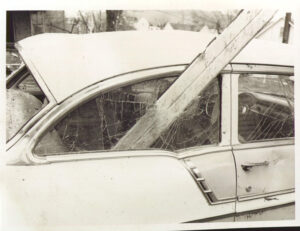By Paul A. Tenkotte, PhD
Special to NKyTribune
Part 1 of a three-part series on the region’s destructive tornadoes
I vividly remember Tuesday, April 23, 1968. It was nine days after Easter. The skies were ominously still. Then, the clouds rolled in, and the day turned stormy and foreboding. At 1:40 pm, a tornado slammed into the small town of Falmouth, in Northern Kentucky’s rural Pendleton County. We listened to news updates on the radio, as my mother led us in prayer in our home in Park Hills, Kentucky.

Piece of siding ripped from home and plunged into car window during tornado., 1968 tornado. (Kentucky Post collection/Kenton County Public Library, Covington, KY.
In its wake, the series of tornadoes along the Ohio River Valley that day left five dead in Northern Kentucky, including four in Falmouth and one in Minerva. In Falmouth, the dead included a 10-month-old girl, a 4-year-old boy, and a 65-year-old couple. In Minerva, a 34-day-old infant girl died.
A cold front pushing from the north collided with a warm front rising from the south over Northern Kentucky that day, producing unstable weather conditions. As early as 11:45 am, the National Weather Service had issued a tornado watch. At about 1:40 pm, radar at Greater Cincinnati Airport in Northern Kentucky spotted the touchdown of a tornado between Dry Ridge and Falmouth. With no tornado sirens then available and the storm moving at a rapid speed, the residents of Falmouth sadly had no warning.
According to the Cincinnati Post, Ralph Weaver, a Falmouth car dealer was among the first to spot the tornado, which hit the town dead-center, near the Falmouth Elementary School. In fact, children watched from classroom windows, as glass dangerously shattered around them. As Weaver related, “I saw a black funnel cloud come down from out of the overcast and roofs started flying. Cars on the street were smashed all to pieces and fire was jumping down from the electric wires” (Cincinnati Post, April 24, 1968, p. 1).

Piece of metal roofing wrapped around a tree, 1968 Falmouth tornado. (Kentucky Post collection/Kenton County Public Library, Covington, KY)
According to records of the National Weather Service, the tornado destroyed 180 houses in Falmouth and damaged another 380. A total of 91 people were injured in Falmouth.
Leaving Falmouth, the tornado hit Berlin, Chatham, and Minerva, Kentucky, and then the little town of Dover along the Ohio River. There, the tornado severely damaged 115 of Dover’s 127 homes. Then, the twister crossed over the Ohio River, flinging up water, and crashed into Ripley, Ohio. Northeast of Ripley, the Falmouth tornado claimed its sixth and final victim, a woman in her 80s. The twister then continued its destructive path through Brown and Adams Counties, Ohio.

Man sitting in rubble, 1968 Falmouth tornado. (Kentucky Post Collection/Kenton County Public Library, Covington, Ky.)
The National Weather Service officially rated the Falmouth tornado as an F4 on the Fujita scale. That means that it was a “Devastating Tornado,” with winds clocking anywhere from 207 to 260 miles per hour. It claimed a total of six lives. Other tornadoes that same day along the Ohio River Valley added to the day’s toll, including a deadly F5 tornado (261-318 mile-per-hour winds) that struck Wheelersburg, and Gallipolis, Ohio, killing seven.
Although our family escaped harm, I remember that my little heart—not yet eight years old—
was saddened by the death and destruction. But as all residents of the Ohio Valley discover sooner or later, it would not be the last time that destructive tornadoes would slam into our valley.
Paul A. Tenkotte, PhD is Editor of the “Our Rich History” weekly series and Professor of History and Gender Studies at Northern Kentucky University (NKU). He also serves as Director of the ORVILLE Project (Ohio River Valley Innovation Library and Learning Enrichment), premiering in Summer 2024. ORVILLE is now recruiting authors for entries on all aspects of innovation in the Ohio River Watershed including: Cincinnati (OH) and Northern Kentucky; Ashland, Lexington, Louisville, Maysville, Owensboro and Paducah (KY); Columbus, Dayton, Marietta, Portsmouth, and Steubenville (OH); Evansville, Madison and Indianapolis (IN), Pittsburgh (PA), Charleston, Huntington, Parkersburg, and Wheeling (WV), Cairo (IL), and Chattanooga, Knoxville, and Nashville (TN). If you would like to be involved in ORVILLE, please contact Paul Tenkotte at tenkottep@nku.edu.

Aerial view of 1968 Falmouth tornado damage. (Kentucky Post collection/Kenton County Public Library, Covington, KY.)
























